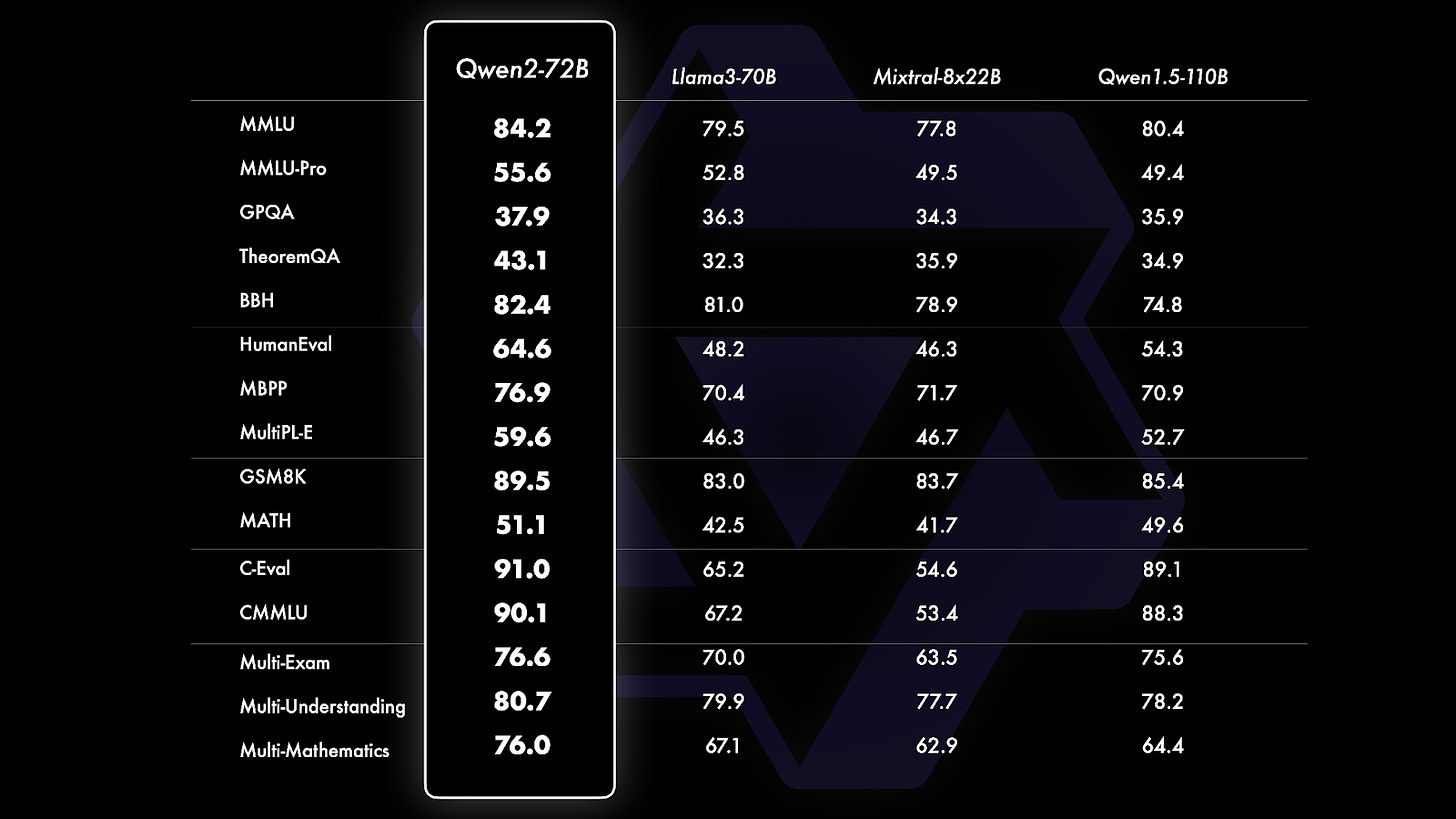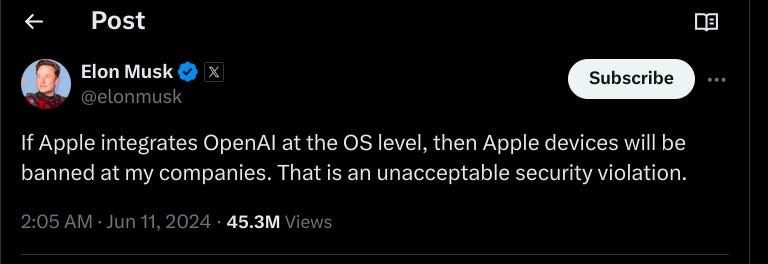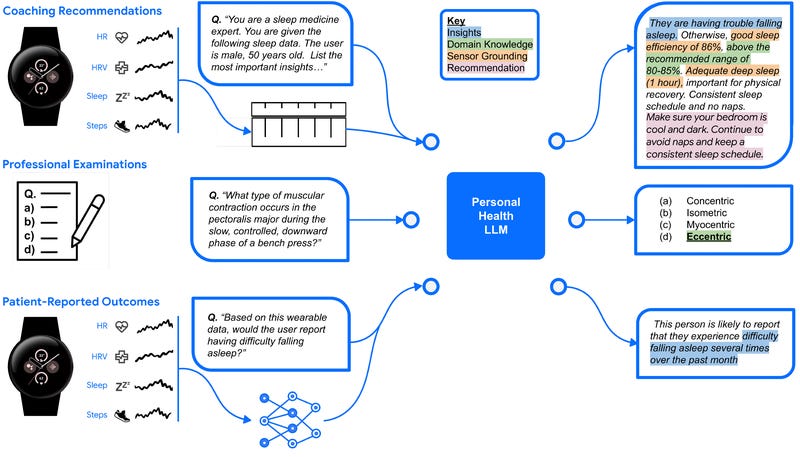AI Weekly Rundown (June 08 to June 14)
Major AI announcements from Apple, Nvidia, Luma AI, Microsoft, and more.
Hello Engineering Leaders and AI Enthusiasts!
Another eventful week in the AI realm. Lots of big news from huge enterprises.
In today’s edition:
🚀 Alibaba's Qwen2 AI models outperform GPT-4 & Llama-3
🧠 SAP announces new AI enhancements with Nvidia
🕵️♂️ Chinese tech giants exploit Nvidia AI chip loophole
🍎 Apple introduces Apple Intelligence, its flavor of Gen AI
🚫 Musk threatens to ban Apple devices over ChatGPT integrations
💼 OpenAI hires Nextdoor and Instagram veterans as CFO and CPO
🛑 Microsoft to discontinue GPT Builder from Copilot Pro
🤖 Autonomous driving by musculoskeletal humanoids: A study
⚖️ Musk drops lawsuit alleging OpenAI strayed from its mission
🎦 Luma AI’s dream machine debut sparks AI media wars
🖼️ Stability AI's diffusion 3 shakes up image creation
💰 No cash involved! Apple will pay OpenAI in distribution
📊 Google’s PH-LLM reads your wearables’ data for insights
🔮 Ex-OpenAI researcher on what to expect from AI in next decade
🧠 DeepMind’s AI ‘virtual rodent’ to understand brain activity
Let’s go!
Alibaba's Qwen2 AI models outperform GPT-4 & Llama-3
Alibaba launched Qwen2 with five sizes ranging from 0.5B to 72B parameters. These models are trained in 27 additional languages besides English and Chinese, showcasing state-of-the-art performance in benchmarks. The models deliver significantly improved performance in coding and mathematics and extended context length support up to 128K tokens. Despite having fewer parameters, qwen2-72 B outperforms leading models like Llama-3-70B and its predecessor Qwen1.5-110B.
Qwen2-72B-Instruct performs comparably to GPT-4 in terms of safety and significantly outperforms Mistral-8x22B. The models are released under Apache 2.0 and Qianwen License on Hugging Face and ModelScope.
SAP & Nvidia are developing applications with AI & digital twins
At SAP's Sapphire event in Orlando, Florida, SAP and NVIDIA announced their collaboration to enhance SAP's generative AI copilot, Joule, with two new capabilities: SAP Consulting and ABAP Developer. These new features are powered by NVIDIA AI Enterprise software.
Additionally, SAP is integrating NVIDIA Omniverse Cloud APIs into its Intelligent Product Recommendation solution to simplify the buying and selling process for complex products. This integration will allow salespeople to visualize 3D product digital twins directly within the SAP Intelligent Product Recommendation interface, making it easier to understand the products.
Chinese tech giants exploit Nvidia AI chip loophole
The U.S. government prohibits Nvidia from selling A.I. chips directly to Chinese companies due to national security concerns. Still, ByteDance is accessing Nvidia's A.I. chips for its U.S. operations by leasing them from Oracle, as the current U.S. rules do not explicitly prohibit Chinese companies from accessing the chips if used within the U.S.
Other Chinese tech giants like Alibaba, Tencent, and China Telecom seek similar arrangements with U.S. cloud providers. The U.S. Commerce Department proposed a rule to tighten controls, but it faced opposition from cloud providers and remains in limbo.
Apple introduces Apple Intelligence, its new Gen AI tech
Apple unveiled Apple Intelligence at WWDC 2024, a personal intelligence system deeply integrated into iOS 18, iPadOS 18, and macOS Sequoia. Leveraging Apple silicon's power, it understands and creates language/images, takes actions across apps, and simplifies tasks using personal context. With Private Cloud Compute, Apple sets a new privacy standard in AI by flexibly processing between on-device and dedicated Apple silicon servers.
Apple Intelligence will power new features like AI-generated Bitmojis, natural language images, and video search, as well as enhanced integration with apps and Siri.
Apple also partnered with OpenAI to integrate ChatGPT with its apps, including Siri. This will allow users to directly access GPT-4 through Apple's platforms. Additionally, Apple confirmed plans to work with other models in the future, including Google's Gemini. The iPhone 15 Pro and devices with M1 or newer chips will be the first to receive the full suite of Apple Intelligence features.
Musk threatens to ban Apple devices over ChatGPT integrations
Elon Musk threatens to ban iPhones and other Apple devices from his companies, such as Tesla, SpaceX, and xAI, over Apple’s announcement of ChatGPT integration into its OS. Musk thinks this integration will allow ChatGPT to access too much private user data through Apple devices. He claims Apple doesn't understand OpenAI's tech and is putting user privacy at risk.
However, Apple and OpenAI stated that users will be asked permission before any data is sent to ChatGPT.
OpenAI hires Nextdoor and Instagram veterans as CFO and CPO
OpenAI has hired two experienced executives to fill important leadership roles. Sarah Friar, previously the CEO of the neighborhood app Nextdoor, was appointed OpenAI's new chief financial officer (CFO). Kevin Weil, a former Instagram and Twitter executive who oversees product teams, has been named OpenAI's chief product officer (CPO).
As CFO, Friar will manage OpenAI's financial operations and investments as the company expands globally. As CPO, Weil will lead product development utilizing OpenAI's AI research to create new products for consumers and enterprise customers.
Microsoft to discontinue GPT Builder from Copilot Pro
The tool allowed users to create custom versions of the Copilot AI service. However, starting from July 10, 2024, Microsoft will discontinue the ability to create GPTs. All existing GPTs created by Microsoft and by customers will be deleted between July 10 and July 14, 2024. Users who created custom Copilot GPTs can save their instructions for reference before their removal.
Microsoft is reassessing its strategy for consumer Copilot extensibility, prioritizing core product experiences while remaining committed to developer opportunities. As part of this shift, it will focus on GPTs for Commercial and Enterprise scenarios.
Autonomous driving by musculoskeletal humanoids: A study
The research paper discusses the development of a musculoskeletal humanoid robot, Musashi, designed to perform autonomous driving tasks. It mimics the human body in detail with redundant sensors and a flexible body structure that are suitable for motions with complex environmental contact.
The robot is expected to sit down on the car seat, step on the acceleration and brake pedals, and operate the steering wheel by both arms.
The paper extensively discusses the hardware and learning-based software necessary for this unique approach to autonomous driving.
Musk drops lawsuit alleging OpenAI strayed from its mission
Elon Musk abruptly dropped his lawsuit against OpenAI. The suit centered around OpenAI’s non-adherence to its original mission of creating AI technology for the benefit of humanity. Musk claimed that OpenAI had shifted its focus away from altruistic endeavors and was prioritizing profit-making ventures.
The case was dismissed without prejudice, meaning Musk can refile it later if he chooses to. However, the reasons behind Musk's decision to withdraw the lawsuit remain unclear.
Enjoying the weekly updates?
Refer your pals to subscribe to our newsletter and get exclusive access to 400+ game-changing AI tools.
When you use the referral link above or the “Share” button on any post, you'll get the credit for any new subscribers. All you need to do is send the link via text or email or share it on social media with friends.
Luma AI’s dream machine debut sparks AI media wars
LumaAI has launched Dream Machine, an AI-powered video generation system capable of generating high-quality videos via simple text prompts. The open-for-all AI tool takes about two minutes to generate a realistic five-second video clip to render specified objects and environments without compromising coherency.
Stability’s diffusion 3 medium set to disrupt image generation
Stability AI has launched its most sophisticated text-to-image AI open model, optimized for consumer PCs and enterprise-tier GPUs. The model delivers several noteworthy features:
Enables photorealistic and high-quality outputs in exceptional style by providing images with extraordinary color, lighting, and details.
Can comprehend long, complex prompts that involve spatial reasoning, compositional elements, actions, and styles.
Leverages Diffusion Transformer architecture to achieve exceptional text quality, reducing spelling, character spacing, and letter-forming errors.
Displays the ability to absorb minute details from small datasets, making it an ideal model for customizing and fine-tuning.
Apple to ‘pay’ OpenAI in distribution, not dollars
A landmark arrangement between OpenAI and Apple to integrate ChatGPT into iPhone, iPad, and Mac was unclear in its financial terms. People briefed on the matter suggest that the agreement isn’t likely to generate revenue for either party and simply provides OpenAI brand exposure to Apple's user base while offering Apple an advanced chatbot feature.
Google‘s PH-LLM reads your wearables’ data
Building on the next-gen capabilities of Gemini models, Google has presented research that highlights two complementary approaches to providing accurate personal health and wellness information with LLMs.
The first introduces PH-LLM, a version of Gemini fine-tuned to understand and reason on time-series personal health data from wearables such as smartwatches and heart rate monitors. The model answered questions and made predictions noticeably better than experts with years of experience in the health and fitness fields.
In the second paper, Google introduces an agent system that leverages state-of-the-art code generation and information retrieval tools to analyze and interpret behavioral health data from wearables. Combining these two ideas will be critical for developing truly personalized health assistants.
What to expect from AI in the next decade?
A researcher fired from OpenAI, Leopold Aschenbrenner, published a 165-page essay on what to expect from AI in the next decade. And GPT-4 has summarized it! Here are some key takeaways from the essay:
By 2027, AI models could reach the capabilities of human AI researchers and engineers, potentially leading to AI surpassing human intelligence
Trillions of dollars are being invested into developing the infrastructure needed to support these AI systems
Controlling AI systems smarter than humans(the 'superalignment' problem) will be crucial to prevent catastrophic outcomes
Only a few hundred people truly understand the scale of change AI is about to bring
DeepMind’s AI ‘virtual rat’ to understand brain activity
Researchers from Google DeepMind and Harvard built a ‘virtual rodent’ powered by AI to help them better understand how the brain controls movement. With deep reinforcement learning (RL), it learned to operate a biomechanically accurate rat model, allowing researchers to compare real and virtual neural activity.
That's all for now!
Subscribe to The AI Edge and gain exclusive access to content enjoyed by professionals from Moody’s, Vonage, Voya, WEHI, Cox, INSEAD, and other esteemed organizations.
Thanks for reading, and see you on Monday. 😊





